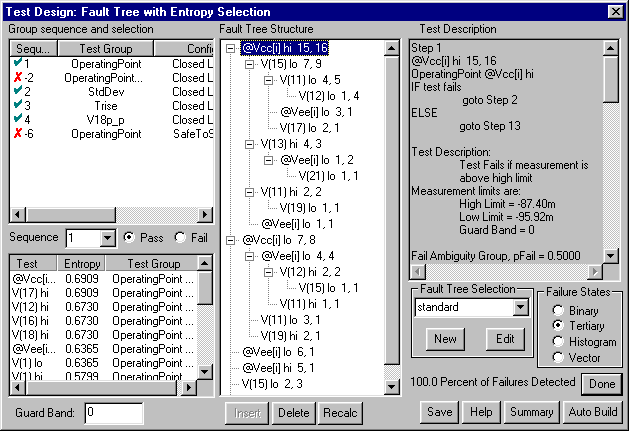
![]()
 |
|
|
|
|
|
|
|
Test Designer provides a generalized set of capabilities in the following areas: Features of ICAP/4Windows - Full system, board and IC level simulation of circuits containing analog, mixed-signal, mechanical, behavioral, and AHDL elements and circuitry Features of Design Validator - Design Validation and verification plus
|
The Test Designer Fault Tree Design Dialog
|
The
following steps are required in order to create a fault tree:
|
|
Fault tree-based tests also provide fault detection for product acceptance tests. Each fault tree has an input which is the list of failures that are to be detected, including “no fault”. Perfect fault detection requires the final tree exit to contain only the “no fault” failure mode. The best fault detection sequence is the one which arrives at this “no fault” conclusion with the least amount of work. Test Designer accomplishes this task by sequencing tests based upon an entropy algorithm which measures the probability of the pass/fail outcomes. For fault detection, setting the “no fault” probability weight to a high value will bias the test flow such that the no fault outcome will occur with the minimum number of tests; this is the least amount of work. Fault isolation information is still available and is used to repair faulty units, or simply as quality control feedback if the circuit can’t be repaired (e.g. an Integrated Circuit chip). The philosophy of generating a test sequence based on known fault behavior assumes that most failure modes can be predicted, and that they tend to be catastrophic [1]. The assumption doesn’t need to be perfect in order to be effective; however, it must account for the majority of the failure rate. When most of the failure rate is predictable, then the fault isolation process will only be incorrect in unusual situations. In other words, the strategy will be correct most of the time, which is the desired result. Two special cases which are handled differently are: Global parametric failures within IC’s. For example, threshold voltage in a MOS circuit would cause multiple failures and would produce poor results using this strategy. The good news is that this kind of process failure doesn’t need to be detected using circuit functional tests because it is detected using process control devices on the IC wafer. The circuit is presumed to be designed so that it will work when process variations are within acceptable limits. [2] When parametric culling is employed, e.g. selecting from the central part of the statistical distribution in order to get high precision parts, the appropriate yield prediction technique is the Monte Carlo analysis. The division between catastrophic and passable circuits is still well defined using the fault model approach. Thus far, work which has been used to model IC failure modes from local defect models has confirmed the tendency toward catastrophic failure modes. This validates the fault model approach which is used in Test Designer. |